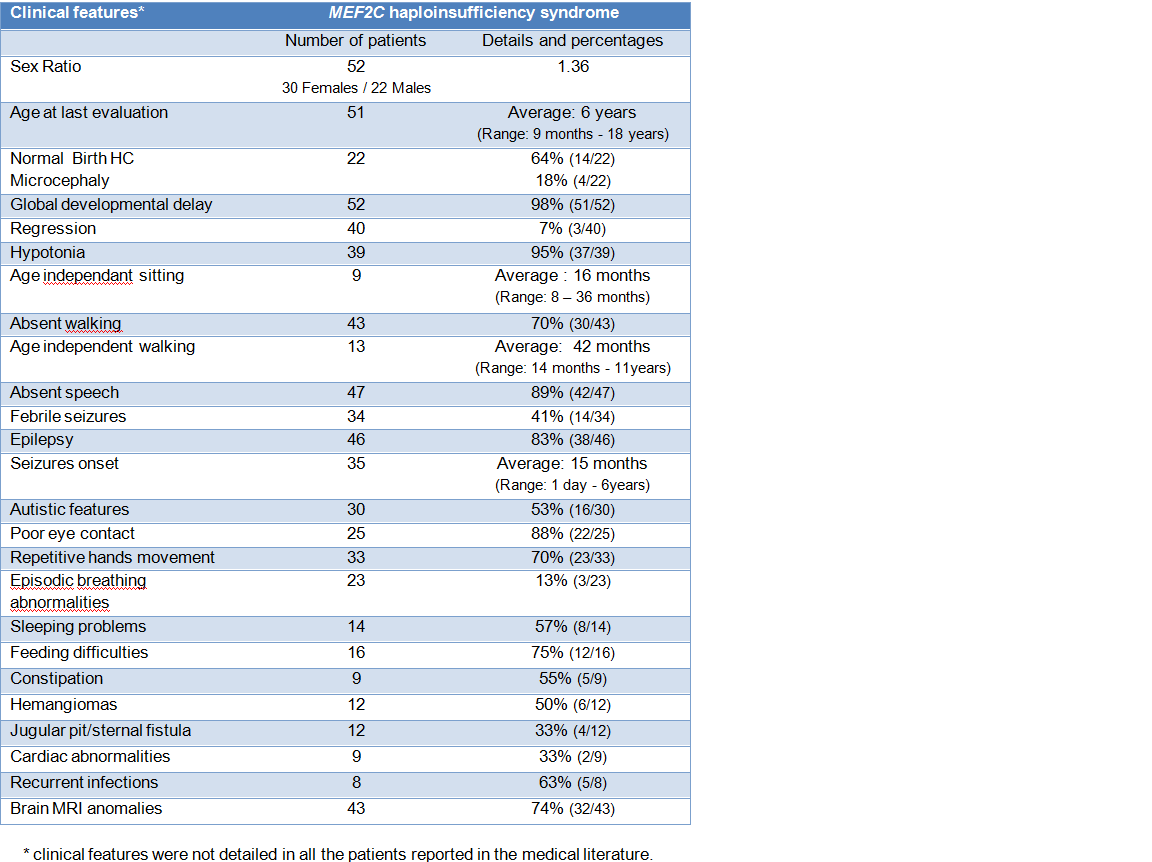People with MEF2C haploinsufficiency syndrome have variable degrees of developmental delay, hypotonia, seizures, stereotypic movements and characteristic (through subtle) facial features.
Not all individuals with a pathogenic variant in the MEF2C gene have these features.
People with chromosome 5q14.3 microdeletions may have other genes within the deletion, and this can increase the likelihood of medical problems over those with pathogenic variants limited to the MEF2C gene.
Medical concerns
- Hypotonia: Most babies have hypotonia (95%) commonly known as ‘floppy baby syndrome’, which is a state of low muscle tone.
- Seizures: Most affected individuals (83%) have variable types of epilepsy, although they can also be seizure-free. The average age for seizure onset is 15 months, ranging from 1 day to 6 years. Most of the times, the seizures respond well to medication. Febrile seizures are also common (41%).
- Feeding: Most children have feeding difficulties (75%) and constipation (55%) in early childhood and infancy.
- Eyesight: Most children have poor eye contact (88%). Ametropia, which is an abnormal refractive condition of the eye (such as myopia, hyperopia, or astigmatism), and strabismus are frequent.
- Skin anomalies: Hemangiomas are a common and characteristic feature in people with MEF2C haploinsufficiency syndrome (50%). A few affected individuals (33%) have a small and subtle skin defect at the bottom of the neck called “jugular pit” or “sternal fistula”.
- Heart problems: Heart anomalies have been reported in two people with MEF2C pathogenic variants although is not yet clear whether this is a definite feature of the condition.
- Breathing problems: Recurrent infections are frequent (63%). Some patients have episodic breathing abnormalities.
Development
- Physical development: most children manifest delay (98%) in reaching their motor milestones (sitting, crawling, cruising and walking) compared with other children of the same age. Some people with MEF2C haploinsufficiency syndrome do learn to walk. The average age for independent sitting is 16 months (ranging from 8 to 36 months) and the average age for independent walking is 42 months (14 months to 11 years).
- Speech: most people with MEF2C haploinsufficiency syndrome have severely impaired or absent language (89%). Few patients developed some limited speech and communication abilities.
- Learning: most children require support with their learning, focused on non-academic and daily living skills. A proportion may attend a special school. One patient with chromosome 5q14.3 microdeletion was reported with mild learning difficulties and normal speech.
- Behaviour: children frequently have autistic features (53%) and stereotypic behaviour as repetitive hands movement or head rocking. Problems with sleep have been frequently reported (57%).
- Using their hands: most children have repetitive hand movements (70%) as hand flapping, clapping, mouthing or biting.
Growth
- Most babies were usually born with an average head size, weight and length and continued to grow appropriately. A few babies (18%) with MEF2C pathogenic variants have a significantly reduced head size called microcephaly.
People with MEF2C duplication
Only three patients have been reported in the medical literature. The 3 patients had global developmental delay. One patient had an impaired but understandable speech. Another patient had seizures from 2 years of age.
More patient data is needed to examine the clinical presentation of patients with MEF2C duplication in more detail.

